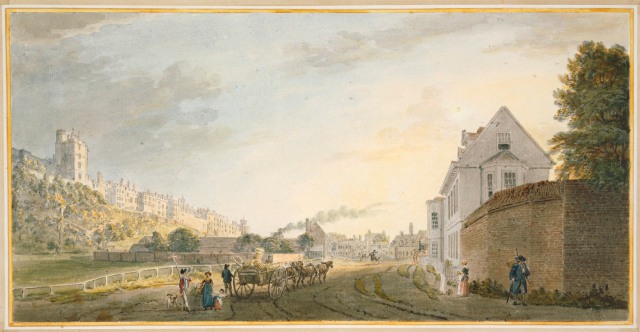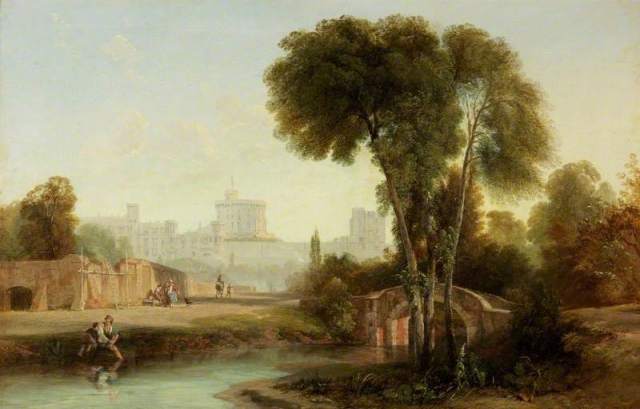Having looked at the landau and royal weddings, how could we not report on Windsor Castle. So, we have some news for you from the Georgian Era.

Breaking News
In October 1804 his Majesty, King George III was determined to no longer reside at the Queen’s House, in the Park, but to remain altogether at Windsor, those who have apartments in Windsor Castle, including the George, Prince of Wales and other Princes, have been desired to remove, as their apartments will in future be required for the accommodation of his Majesty’s family. Orders have been given, it is said, to remove the Royal Library, one of the finest in the country, and everything else connected with the convenience or pleasure of his Majesty’s residence at Windsor, from the Queen’s house, in the Park. The Duke of Gloucester will also quit Cranford Lodge, and the Honourable George Villiers, brother to Lord Clarendon, will in future reside there, and have a very confidential place in the superintendence of his Majesty’s private concerns. He will now come to town only on specific occasions.

In Traffic News
In our next piece of news, we hear of something which many of us living in the UK today will be familiar with – the high volumes of traffic. Clearly, it was no different in 1789!

The King’s most Excellent Majesty has been graciously pleased to make a road from Windsor over Cranbourn Chance thro’ Windsor Forest, leading to the rural villages of Winkfield, Warfield and Binfield to Reading, which is allowed to be the most delightful ride of any in this kingdom, from the many beautiful and picturesque views of seats and parks of several noblemen and gentleman the whole way.
The great annoyance generally complained of by persons travelling the other road, are the frequent obstruction by droves of oxen, sheep and cattle, stage-coaches, road-waggons and carriages, is such a to render if very disagreeable.
The pleasant and elevated situation of Windsor and its castle, dignified by royalty, has ever been the just admiration of foreigners and natives alike.

Improvements to Windsor Castle
Also, from 1801 we hear the King finds much amusement in inspecting the improvements at Windsor Castle and the building of the Royal Palace at Kew. His Majesty, George III, rises regularly at seven o’clock, breakfasts at eight with the Royal family; from nine till eleven views the progress of the workmen. Every window in the castle is to be replaced with stained glass.

Visitors to Windsor
On 27th October 1804, the Kentish Gazette reported that:
Sunday morning the royal family attended divine service at St. George’s Chapel, Windsor. As their majesties passed through the courtyard, the 10th Regiment of Light Dragoons and the Staffordshire militia were drawn up, the bands of each playing. A number of spectators were assembled to see their sovereign.

We have some sad news to bring you from 18th May 1800.
William Dick Esquire, Governor of the Poor Knights and for nearly 40 years King’s Clerk, and Clerk of the papers at the Mint and the oldest messenger in his Majesty’s service has died at Windsor Castle, aged 91.
And finally, …
New for the 9th February 1801 was the production of:
Transparent Spring Blinds
Amongst the many ingenious and useful inventions which characterise the present age, the above new idea may be said to have a more than common share of attraction. Transparencies on a small scale drawn on silk, have been much admired; but the taste of the artist has been hitherto confined within very narrow bounds. The invention, above named, gives ample scope for the exercise of talents, and from a happy combination of art and nature, the glowing tints are preserved, and the perspective being kept up by a minute attention to trifling objects in the foreground, the general landscape appears with the happiest effects.
The elegance and utility of this article promise to render it of the first estimation in the eyes of the fashionable world. The Queen has already patronised the idea and a set being made already for Buckingham House and Windsor Castle, from drawings taken of different parts of the country to which her Majesty is most attached.

Featured Image
British (English) School; View of Windsor Castle from the River Thames; National Trust, Anglesey Abbey.

Very good article. i grew up in Winkfield
LikeLike
Aww, thank you so much 🙂
LikeLiked by 1 person
Strangely there are still two roads across there
LikeLike